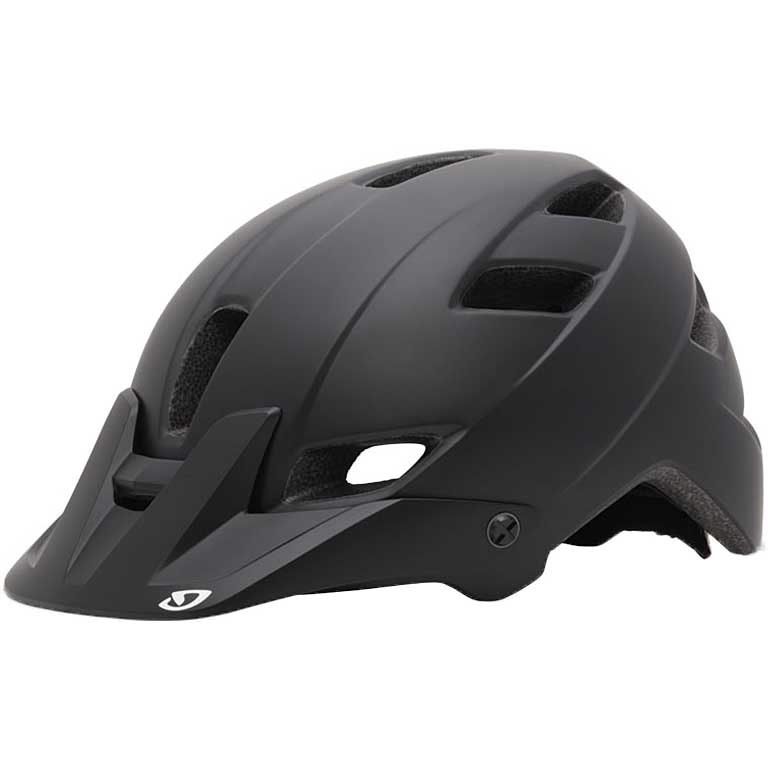Giro Feature MIPS Helmet
Size: Medium (55-59cm)

Color: Matte Black
Blister’s Measured Weight: 349 grams
Reviewer: 5’9” 150 lbs, Head circumference: 57 cm
Features:
- MIPS (Multi-directional Impact Protection System)
- Adjustable moto-style visor
- In-Mold Polycarbonate Shell with EPS liner
- In-Form Fit System
- 12 Vents with internal channeling
MSRP: $95
Duration of Test: about a month
Test Location: around western Montana
Giro’s new Feature MIPS helmet builds off of the existing Feature helmet and adds, you guessed it, MIPS.
This comes by way of Giro acquiring an interest in MIPS – I’ll talk about the MIPS system a bit more below, but in sum, this means that Giro can add some extra safety features to its helmet at a very reasonable price.
But all the safety features don’t really do you any good if the helmet is uncomfortable. Fortunately, the Feature does pretty well all in all.
The Fit
Since fit is important when it comes to finding a helmet, we’ll start there. A good helmet fit is vital, and a sloppy helmet fit significantly reduces the helmet’s ability to protect you in a fall (not to mention it’s annoying when your helmet is banging around on your head).
The Giro fits like, well… a Giro.
When viewed from the top down, my head is more of an oval than a circle, and Giro helmets have always fit this shape pretty well. This is in contrast with Bell, whose helmets are more round. While they’re perfectly nice helmets, I’ve yet to find a Bell that fits me well.
Every company has a different mold shape for their helmets, so the moral of the story: if you don’t know what brand helmet fits you well, try before you buy.
Dialing in the fit is accomplished via Giro’s “In Form” fit system. This boils down to a little dial that cinches the helmet down on your head, similar to lots of helmets from a variety of manufacturers. In my experience, both on the Feature MIPS as well as other Giro helmets, this works great – it’s quick and comfortable, which is about all I can ask for.
Rear coverage on the Feature MIPS is pretty good – it definitely falls into the category of helmets that go more for full protection, and Giro markets the Feature MIPS as geared toward “long-travel trail riding.” I’d say that’s about accurate – the Feature MIPS isn’t built to appeal to the XC crowd.
Construction / Safety
At its core, the Feature MIPS is a pretty standard polystyrene helmet, similar to what Giro has been making for years. That makes it a one hit wonder–when you fall on your head, it’s designed to break, then be replaced.
But of course, the noteworthy part of this helmet is the MIPS (Multi-directional Impact Protection System).
For those unfamiliar with MIPS, it’s a system that came out a few years ago that’s designed to help deal with angular impacts. Without wading into all of the medical principles behind helmets, the general goal is to keep your head from making abrupt changes in direction. Abrupt changes in direction lead to your brain sloshing up against the inside of your skull … since that sloshing carries very unpleasant results.
The normal type of abrupt change in direction that we think about is the rapid deceleration when your noggin meets the earth. And the polystyrene foam is designed to deal with that—it breaks, and, by a tiny fraction of a second, reduces the abruptness of that deceleration. And hopefully that’s enough to keep you from being relegated to the produce aisle.

But vegetablism has more than one flavor, and the MIPS system is designed to deal with rotational impacts.
So when you smash your head into the ground at an oblique angle, you’re not only encountering a rapid deceleration, but your brain is also rapidly re-vectoring at whatever angle your head is getting deflected. And that change of direction is what the MIPS system helps with.
Basically, MIPS is just a slippery piece of plastic on the inside of the helmet. It’s situated between the pads that rest on your head, and the polystyrene body of the helmet.
It’s a fairly thin, flexible layer – just thick enough that it has a little bit of rigidity to it. And it slips around quite easily; with minimal force, it can shift and twist about a centimeter in any direction. So the idea is that when you’re bouncing your head off a rock, the MIPS system will help slow down that rotation or change in direction by just a little bit so you’re able to ride another day.
Does it work? There’s no question that the MIPS system allows the helmet to more easily rotate on my head in an impact – smacking myself in the head proves that pretty easily. But I haven’t taken a real digger in the Feature, nor am I a qualified medical professional. If (and when) I end up packing my head into the ground, my best guess is that it certainly won’t hurt to have MIPS in the helmet.
Venting
Good venting is an endless struggle for helmet manufacturers: more vents means that a helmet breathes better and is probably lighter, but it also makes it tougher to make sure the helmet still protects you well.
The Feature MIPS isn’t winning any awards for its venting. While its 12 vents are relatively large, there’s still a fair amount of real estate that’s solid foam. And riding in the Feature MIPS, this is pretty apparent; it’s one of the warmer helmets I’ve ridden in. Most of my time in the Feature was in relatively cool temperatures – 50-70° Fahrenheit, but even in those cool temps, I noticed that my head was coming away from the ride pretty sweaty.
Part of this, I suspect, is due to the MIPS system. The plastic MIPS shell partially blocked a couple of the front vents, and it seemed to also impede airflow around the inside of the helmet. Most helmets (the Feature included) have internal ridges to help air flow from the front of the helmet to the back. But when there’s a plastic shell in between your head and those ridges, any resultant air flow doesn’t really do you all that much good. Popping the helmet off after a ride, it was normal to see sweat beaded up on the plastic MIPS shell.
Other Features
Giro has finally seen the light on its straps. Gone are the somewhat awkward and never-flat straps of yore. The Feature MIPS’s straps are light, plenty adjustable, and most importantly, lay nice and flat around my ears. I’m a fan.
It’s a fairly minor point, but I always check a helmet’s ability to hold sunglasses. My generic sunnies can be crammed into some of the upper vents on the Feature, but it’s not an ideal fit. I’ll stick them there occasionally while drinking post-ride beers at the trailhead, but I wouldn’t actually ride with them there.
The visor on the Feature MIPS is a good one – it’s big enough that if you actually need a visor, it’ll actually do something other than just differentiate the helmet from something you’d wear on a road ride. And the fittings holding it in place are solid enough that it doesn’t move around, even if you bash your head through a low-hanging branch.
Bottom Line
The Feature isn’t the fanciest, lightest, or most ventilated helmet I’ve ever worn, that much is certain. But it has some pretty noteworthy safety features, and most importantly, it’s priced extremely reasonably. Not long ago, a MIPS-equipped helmet would have run you somewhere in the neighborhood of $200 (or more). Now you can get that same technology for less than $100.
If you run hot or live in an area with a warmer climate, you might want to bump up to something with more vents. But if you’re looking for a great value in a helmet that sports the latest and greatest in safety features, the Feature is a fantastic option.
